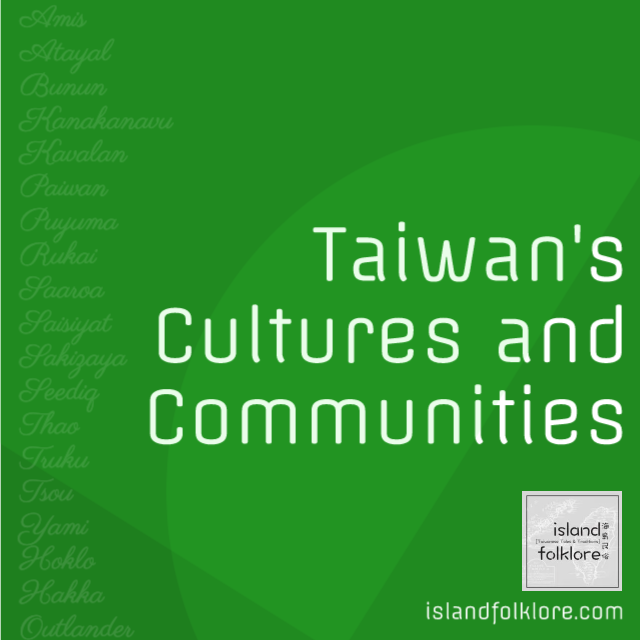Fireflies are known in the Taiwanese language as Hóe-kim-ko·, literally the “fiery maiden of gold” or the “golden maiden of light.” It was originally the name of a young girl. The following is a short, tragic tale that tells of how fireflies came to be and how they got their name.

Throughout China’s long history, Taiwan was a mysterious and unknown place off the coast of that ancient civilization. Despite the island’s proximity to the continent, the Chinese have historically shown very little interest in Taiwan.
The Chinese conceived themselves a continental people and traditionally expanded their influence by following the Silk Road to Central Asia or south to the jungles of Vietnam and northeastward to Manchuria and Korea.
Aside from these narrow channels for expansion, the Chinese were historically hemmed in by the arid deserts of Mongolia, the hostile environment of the Tibetan plateau and the horrifying emptiness of the Pacific.
Neither were the Chinese much interested in expanding. China’s Great Wall, a premodern engineering feat, was designed as much to keep outsiders out as it was to keep the Chinese in. There was, after all, “no place like home.”

All of this changed, however, in the 17th century with the arrival of the Dutch East India Company in Taiwan.
The Dutch set up a successful trading colony in southwestern Taiwan. This European presence, so close to their borders, compelled southern Chinese communities to engage with this island beyond their continental homeland—clashing with Taiwan’s indigenous peoples.
By the beginning of the 18th century, ethnic Han Chinese presence in western Taiwan became firmly established. The Dutch abandoned their colony in 1661, after successful invasions by the Sino-Japanese pirate king, Koxinga.
After several more decades of war, Taiwan’s pirate and indigenous kingdoms came under the suzerainty of the emperor in Beijing. Taiwan became a satellite of the empire in China in 1683. This opened the door to mainly Hoklo (Hokkien-speaking) pioneers to settle there. These immigrants laid the foundations of what has shaped the culture of the beautiful isle ever since.
The Taiwanese firefly tale emerged from around this period.

A young Hoklo couple arrived in Taiwan in the 1700s. They came with nothing but the shirts on their backs and hope for a better lot in their new home. It is said, they settled down in a coastal village in increasingly sinicized southwestern Taiwan.
Soon after their arrival in Taiwan, the wife gave birth to the couple’s first child—a beautiful girl they named Kim-ko· (Jīn’gū in Mandarin). Three years later, they had another daughter, whom they named Kim-chhenn (Jīnzhēn in Mandarin). But soon after the second childbirth, the wife became ill and passed away—leaving behind a grief-stricken husband to look after the two girls alone.
The widowed father of two worked hard for his girls and the sisters grew to be kind and loving daughters. The elder girl was caring and considerate. She looked after her father and sister tenderly. The younger sister was more playful and spontaneous.
One day, the father had to travel to a distant township for business. He assured his daughters of his return by sundown.
His errand, however, took longer than he expected and he was forced to take refuge in a small roadside inn that evening.
Back home, the two girls patiently awaited their father’s return. As the hour grew late, they became worried.
Finally, Kim-chhenn, unable to resist her spontaneous nature, went out looking for their father. She dashed out of the house before her sister could stop her. Kim-ko· chased after her younger sister, but in the darkness of the night, they soon became hopelessly separated.
Kim-ko· desperately felt her way through pitched blackness in search of her sister. In the dark of night, she prayed for light to guide her to her family.

The following morning, not long after dawn, the lifeless body of Kim-ko· was discovered washed up by a lake in the woods.
Kim-ko· had stumbled in the night and fallen into the water and drowned. The villagers who discovered her noted orbs of light drifting and circling around her, as if little stars or fiery golden beings had descended to earth from the heavens.
The gods had answered their suppliant and created fireflies to light her way. But alas, they heard the prayers too late.
The villagers named these mesmerizing and beautiful creatures in the memory of the maiden who passed. They gave the fireflies her name with the hóe prefix meaning “fire” or “light.”
To this day, these beautiful insects of the summer’s night are still called Hóe-kim-ko· by the Taiwanese people in honour of this tale and its tragic heroine.





